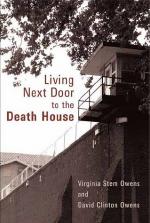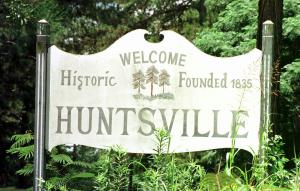Issue Date: July 4, 2003
Reviewed by JAMES MEGIVERN In the year 2000 Huntsville, Texas, was rated as one of America’s “dream towns,” a quiet community with a high quality of life, a good university, and many pleasant cultural assets. And yet, “the only picture most people have of Huntsville” is due to a single room at the Walls prison compound -- the death chamber. “The effect of what goes on in that small room reaches out like tentacles to touch the lives of everyone who lives there.” Such is the thesis of an impressive new book examining the reality of Living Next Door to the Death House. Its main voice is that of Virginia Stem Owens, whose lifelong association with the town is the basis for both its title and its uniqueness. What makes this far more than a personal memoir, however, is the fact that she and her husband, David, consistently interweave their own perceptive insights into a series of extended interviews with townspeople. The reader is progressively introduced to an entire cast of local folks involved in all aspects of the capital punishment system. The result is a broad awareness of how the constant performance of state killings has to affect a community, even though few want to talk about it openly. The direct way in which the hard questions are asked and the conversations are conducted makes the book an unusually interesting and informative work. It especially shows how completely the system focuses on punishment, making the criminal the center of attention, while victims are reduced to “merely evidence … little more than pawns in the game of justice.” Relevant anecdotes deliver much of the book’s impact, especially in the interviewing of professional insiders. Two seasoned defense attorneys reveal aspects of their cases that went all the way to the U.S. Supreme Court, ultimately to no avail. Wardens and guards tell of how the system has changed dramatically since the 1982 start of the “new” death penalty with its clinical lethal injection apparatus. The hard-nosed vindictiveness that has now become the system’s trademark was not always the prevailing sentiment. But with 300 executions performed in Huntsville in the last 20 years, far more than anyplace else in the country, the town somehow borders on the unreal. How can such an “industry” fail to generate a community marked by a great deal of bad faith?
Some of those responsible for doing the dirty work began their employment long after Old Sparky had been retired and consigned to a museum and the death chamber was empty and inactive. One of these men, late in his career, became head warden and in three years had to supervise the demise of no less than 89 prisoners. With deeply conflicted feelings, he admitted to the Owenses that he found intentional killing of human beings an “unnatural act,” and that he was especially bothered by the realization that some convicts had changed their lives and “were not the same men who committed the crime,” while others, he was convinced, were actually innocent, the hapless victims of a badly flawed system that its functionaries have to pretend is beyond valid criticism. This particular interview led the authors to observe, “The system is intentionally designed to so distribute the accountability for executions that no single individual need ever feel the full force of responsibility,” from the governor who signs the death warrant down to the technicians who insert the poison-bearing needles. It is crucial for its survival that the process be kept completely impersonal so that nobody has to take the blame for what is being done. Another interview was with a man who had been on the “tie-down” team for 10 years. As one of four officers -- each responsible for securing one of the prisoner’s limbs to the gurney -- he had played this minor role in carrying out a grand total of 130 executions. The last time, however, the prisoner was not a man but the first woman to be killed in the Walls death chamber, Karla Faye Tucker (Feb. 3, 1998). He recalled that she went to her death “with a smile on her face. … She looked at me and said, ‘We’re going to all be forgiven.’ ” Two days later he broke down in public and quit his job, telling the warden, “I can’t do it no more! … Just because it’s the law doesn’t make it right. … It’s not right, it’s just not right.” Another insider who was present in the death chamber for even more executions was a prison chaplain who had stood beside the gurney for a total of 160 executions, “his hand resting just below the knee of the condemned, the last human touch they ever felt in this world.” Whatever the chaplain’s deeper sentiments about all this, the authors indicate that he was reassigned after making critical remarks to the media following Karla Faye Tucker’s death. In his new position he serves as a mediator between victims and offenders, trying to heal at least parts of badly broken lives instead of just watching them being snuffed out by the vindictive order of the state. Such a shift requires a very different paradigm. “Currently we ask who did it and how can we punish them,” he said. “But it makes more sense to ask who was hurt and how can we restore them.” The Owenses end their reflections on Huntsville, the death penalty capital of the country, with a positive and “most astounding discovery.” Those they have met and interviewed in depth are in positions to know, and they “testify to the fact that many offenders do deeply desire … to ‘come clean.’ ” The great tragedy is that the system, the state, the culture, the politicians and the media are so totally fixed on exacting revenge that there is no room for even considering any other policy than routinely killing killers. What would be needed for anything else to be tried would be for a critical core of people with enough imagination to envision an alternate society, one that can learn how to “do justly and to love mercy” rather than abdicating their humanity and going along with a system that disposes of fellow human beings as so much garbage. The book is not an assault on the death penalty as such but a challenge to those who would accept death-dealing as a valid part of the state’s ordinary business. Living Next Door to the Death House can indeed result in mindless complacency. But it can also, ironically, lead to a more intense realization of how much the system depends on people agreeing to wear the masks of “bad faith.” As the Owenses illustrate, one way to be a conscientious resident of Huntsville (or anyplace else) is to foster “good faith” efforts to find a better way to practice justice. Their book is certainly a welcome contribution to that effort. James J. Megivern is professor emeritus at the University of North Carolina at Wilmington. National Catholic Reporter, July 4, 2003 |

